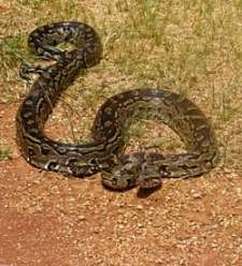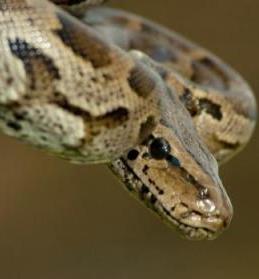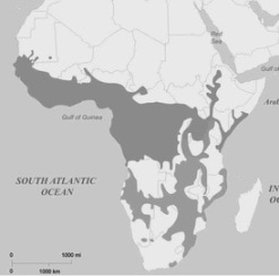African Rock PythonPython sebae |

Custom Search
|
|
The African Rock Python (Python Sebae) is Africa’s largest snake, it has a long, stout body, patterned with blotches that will vary in color between brown, olive, chestnut and buffy yellow, often joining up in a broad, irregular stripe.
The scientific name Python Sebae derives from the Greek mythology and refers to a huge serpent. And it lives to the expectation as this is one of the largest snakes in the world. They have a triangular shaped head that has many sharp, backward-curved teeth, with a mark on top with a dark brown “spear-head” outlined in a buff yellow. Under the eyes are distinctive triangular markings, known as the subocular mark. Like all pythons, the scales of the African rock python are small and smooth to the touch, and those around the lips are fitted with heat-sensitive pits, similar to those found on venomous pit vipers. Which the snake uses to detect their warm-blooded prey, even in total darkness. Unlike other more ‘advanced’ snake species which have only one lung Pythons possess two functioning lungs. They also have small but visible pelvic ‘spurs’, these are believed to be the vestiges of hind limbs. The African rock python varies considerably in size between the different parts of its range. In general, in highly populated regions we will find smaller specimens, like in southern parts of Nigeria. Females are typically larger than males.

This snake only reaches its maximum length of around 7,5 m in areas where the human population density is lower, such as Sierra Leone.
One specimen killed in 1958 and reportedly 7 m (23 ft) in length, was claimed to have had a 1.5 m (4 ft 11 in) juvenile Nile crocodile in the stomach. The southern population can be distinguished by its smaller size with adult snakes averaging about 2.4 to 4.4 meters in length. They feature larger scales on top of the head, a darker coloration, the markings on the back consist of distinct and separated blotches rather than forming an irregular stripe, and the subocular mark is smaller or even absent. Their common name varies among subspecies with northern form sometimes referred to simply as rock python, while the southern specimens are called Natal rock python or just African python. The African Rock Python attractive skin pattern is somewhat similar to that of the Burmese python and in captivity, the 2 species are sometimes confused. In the wild, they live in totally different regions of the world. Just like other pythons, like the Burmese Python, the African rock python is a non-venomous snake and uses constriction to kill its prey. After the snake gets a grip on the prey, it will coil around it, tightening its coils every time the unfortunate victim breathes out. Even so, death is thought to be caused not by asphyxiation or crushing but due to cardiac arrest. Subspecies / Taxonomy
They are one of 11 extant species in the genus Python, with 2 subspecies recognized. The African rock python species was described for the first time in 1788 by Johann Friedrich Gmelin, a German naturalist. While the southern subspecies was described only in 1833 by South African Zoologist Sir Andrew Smith. Some experts consider the more southerly population of this snake to be an entirely different and separate species, known as the Southern African Rock Python (Python natalensis), while in most other cases it's considered a subspecies. African rock python (Python sebae sebae - Gmelin, 1788) - Found in Central and Western Africa. Southern African rock python (Python sebae natalensis - Smith,1833) - Found in the southern part of the African continent. Diet / Feeding The African rock python main diet consists of a variety of large rodents, African antelopes, monkeys, fruit bats, monitor lizards and even crocodiles in forest areas, and on rats, poultry, dogs, and goats in suburban areas. A few documented cases are also known of this large python species hunting down and killing humans, like this case of one killing and eating a young boy. Reproduction The African Rock Python becomes sexually active at the age of 3 to 5 years old and they reproduce during the spring. The female lays a clutch from 20 up to 100 eggs. The incubation extends for a period of around 2 to 3 months during this time the female will guard the eggs aggressively against any predators. The hatchlings are born with a length of around 18 to 24 inches. Conservation / Threats The species has not yet been assessed for the IUCN Red List. The African Rock Python conservation status is not a matter of concern however they are no longer widespread like the past. The main reason for the species decline is mainly due to human hunting for their skin or meat. Today they are mainly restricted to secluded areas, hunting reserves and parks. African Rock Pythons are listed on appendix 2 of CITES (Conservation on International Trade of Endangered Species) and hence are legally protected, especially in areas where the species is vulnerable and declining.
|
Did You Know?
A group of rattlesnakes is referred to as a "rhumba" or "rumba", find more snake facts for kids. Scientific classification |
© 2014 Snake Facts About Us | Privacy Policy | Contact




